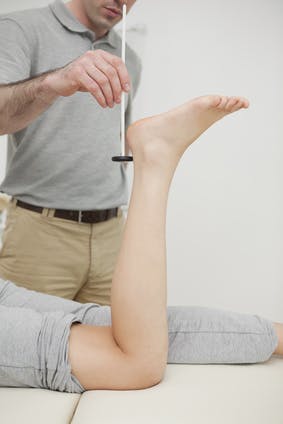Our promise to you.
We will never settle for "average". It is our promise to provide and advance superior physical therapy services while adding uniquely specific and related services to serve the our community and surrounding region with the utmost quality.
Easy Does It
An injury to the heel can have a variety of causes, from arthritis and heel spurs to stress fractures and tendon injuries. It's important for individuals not to overwork the heel. People who aren't accustomed to extensive running, jogging and similar activities should never attempt participation without proper preparation.
Physical therapy can prepare your feet for rigorous usage and relieve the effects of overuse. Physical therapy can help in multiple areas that include:
- Foot or heel supports
- Remedy gait problems
- Reduce plain, inflammation and swelling
- Identify mechanical dysfunction
- Increased foot support
- Improved flexibility
- Build strength and endurance
Pain in the heel and bottom of the foot may be caused by micro-tears in the ligament that's responsible for supporting the arch. Any type of heel pain may develop over time and it can appear suddenly, representing an acute injury. If left untreated, heel and Achilles tendon pain worsens and can transition into a chronic condition.

Heel Pain and Injury: The Physical Therapy Solution
The feet bear the weight of the body upon them, but the heel of the foot receives little thought unless it begins to hurt. Pain can originate under the heel (plantar fasciitis) or the back of the heel in the Achilles tendon. Inflammation, swelling and pain are common complaints associated with the heel.
An injury to any part of the heel can be extremely painful, producing inflammation and swelling. Individuals may have difficulty flexing their foot up or down, standing on their toes, or even walking. A heel injury may also result in a tingling sensation indicating the need for immediate medical care that will often require rehabilitation with a physical therapist.
Everyone has an occasional pain in the heel after extensive walking, jogging or sports activities and it typically disappears within a day or so with rest. Heel pain that interferes in standing, walking, or lasts a week or more can be helped with physical therapy.
Plantar fasciitis is the most common cause of heel pain resulting from running and jogging, obesity, and excessive standing. Pain may be present when people take their first few steps in the morning or after sitting down for an extended period of sitting.

Treat The Pain with Physical Therapy
Your physical therapist can help you reduce the risk of injuring your heel with specific stretches, exercises and warm-ups that will prepare your foot for action. He/she can help you choose the right shoes for specific activities. Footwear varies widely and a shoe that's appropriate for power walking won't be appropriate for jogging or running a marathon.
Many people have developed mechanical dysfunction in their gait that leads to improper foot placement. Your physical therapist can examine your gait while walking, jogging and running to determine if retraining or realignment is necessary. He/she can help if arthritis or chronic conditions are involved.
Orthotic devices can be prescribed to ease pain and distribute weight more evenly for comfort. If you're overweight or your employment requires extensive time in a standing position, your physical therapist can recommend accommodations and ergonomic solutions to relieve stress on the entire foot and the rest of the body.
Manual manipulation may be employed to improve flexibility and mobility. If heel pain is caused by a weakness in the lower leg, hip or core, you'll have access to technologically advanced methods to strengthen those areas and improve endurance. Pain in the heel can originate in the back and spinal adjustments are effective for relieving pain in any part of the body.
Therapeutic massage and electro-stimulation may be used to loosen tight muscles in the calf and foot, relieve pain, and reduce inflammation and swelling. Braces and assistive devices can be obtained to provide support. Your physical therapist may also use dry needling, acupuncture, and joint mobilization to treat and reduce the risk of injury.
You don't have to be a world-class athlete or compete in marathons to experience pain in your heel. It can result from an incorrect step, being overweight, or participating in active endeavors without the proper warm-up. No matter what the source, your physical therapist can help with preventative measures and treatment if an injury has already occurred.

